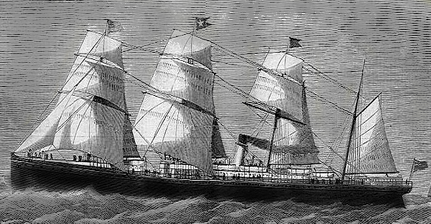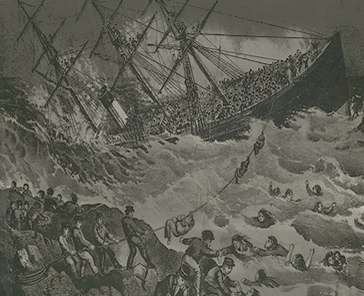RMS Atlantic
RMS Atlantic, yard number 74, was a 3,707 ton four masted steam ship; only the second steam ship to be built for Thomas Ismay’s White Star Line. Sometimes referred to as White Star Line’s first Titanic, Atlantic sank in 1873 with the loss of around 562 lives, after striking rocks in Nova Scotia, the worst disaster in maritime history at the time – and White star Line’s second worst ever disaster, the other being Titanic.

RMS Atlantic.
Atlantic was launched at Harland and Wolff, Belfast on 26th November 1870. Under the command of Captain Digby Murray, Atlantic began her maiden voyage on her intended route, Liverpool, Queenstown, New York, on Thursday 8th June 1871. After having endured strong westerly gales and fog on the journey, Atlantic arrived in New York for the first time on 21st June.
Advertising Atlantic’s first departure from New York, scheduled for Saturday 1st July 1871, an advert appeared in the New York Daily Tribune describing the passenger accommodation for all classes as being “unrivalled, combining safety, speed, and comfort.” It also said that surgeons and stewardesses accompany the ship, and that the ship included saloons, state-rooms, a smoking room and bath rooms in the midship section of the ship, where it was said that the least motion could be felt.
While Atlantic was stationary in Liverpool on 23rd November 1871, the steamship Alexandria struck Atlantic, causing £300 worth of damage to the ship.
As reported by the New York Times on 3rd October 1872, Atlantic was expected to leave New York on 5th October, returning home to the United Kingdom with United States mail and $2,500,000 in Mexican silver dollars, being sent to the Bank of England. The article also noted that the steerage accommodation aboard Atlantic, despite being recently "severely spoken of by correspondents of several journals”, was found to be “of the very best description” and to be “well-lighted, freely-ventilated and cleanly kept.”
After arriving home to Liverpool from New York on 13th March 1873, Atlantic, under the command of Captain James A Williams, departed Liverpool for her 19th and, as it turned out, last voyage, on 20th march 1873. This voyage ended with Atlantic’s name forever being added to the list of worst maritime disasters.
From Liverpool Atlantic sailed to Queenstown, arriving the next day, and upon leaving Queenstown, had abroad around 952 passengers and crew. The first few days of the voyage seem to have been uneventful – but the Captain later stated that on the 24th, 25th and 26, they had endured heavy south-west and westerly gales, causing the ship to slow down.
On 31st March, with an engineer’s report stating that only 127 tons of coal remained aboard the ship, there was a fear aboard that the ship might not have enough coal to reach New York; so, especially considering unfavourable weather conditions, it was decided to head the ship for Halifax, Canada to load more coal aboard.
At around 12am the Captain left the bridge to go to bed, and ordered that his steward should call him at 2.40am and that the deck officers should call him at 3am, or sooner if needed. Left In charge of the bridge were Atlantic’s second and fourth officers. Unknown to the crew, the ship, traveling at around 12 knots, was considerably off course to the west of where she should have been.
Despite the captain’s order to call him, his steward is said to have been told not to do so by the fourth officer, and it appears that, at 3am, the captain was not woken up.
At approximately 3.15am Atlantic smashed into a rock off Marr's Head, Nova Scotia. The passengers and crew started making their way up on to deck – but the port side lifeboats were washed away by the sea, and soon after the ship keeled to port – causing the starboard side boats to become useless; which is said to have helped cause the death of many people still below deck.
It is said that Third Officer Brady, Quartermaster Owens and Quartermaster Speakman managed to tie a line to a rock – allowing those onboard to climb to safety; a long and perilous journey, which many drowned while trying to attempt. With the sea roaring around them and aboard the ship, those on the deck were also ordered to climb up the ships rigging or to get to a safe part of the deck.

An artist’s, EA Bollinger, impression of the sinking.
After Third Officer Brady managed to summon help on shore, boats come from the shore to rescue the survivors. Around 562 of the around 952 people aboard died in the disaster – including all the women and children aboard – except for a boy (possibly 12 years old) called John Hindley.
Many of the victims were buried on the shore near to the wreck site; 277 of whom were buried in a mass grave – following a burial service led by the Reverend William Ancient – who had been involved in the rescue operation. Located on the site is a stone memorial with the following inscription: “Near this spot was wrecked the S.S. Atlantic. April 1st 1873. When 563 persons perished. Of whom 277 were interred in this churchyard. This monument is erected as a sacred memorial by a few sympathetic friends.”
Located at the site, near the wreck site, today the is the SS Atlantic Heritage Park, said to have been built to remember and comemorate the disaster.
The wreck remains sunk at the site today.